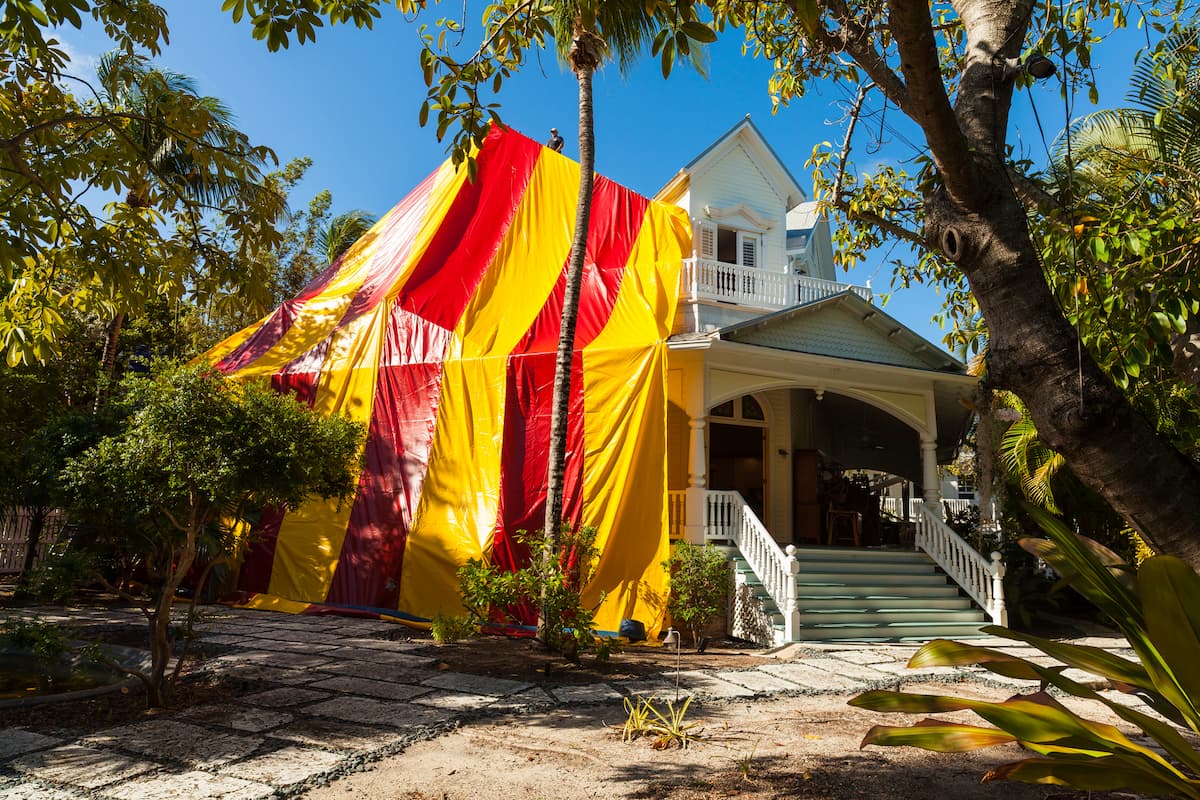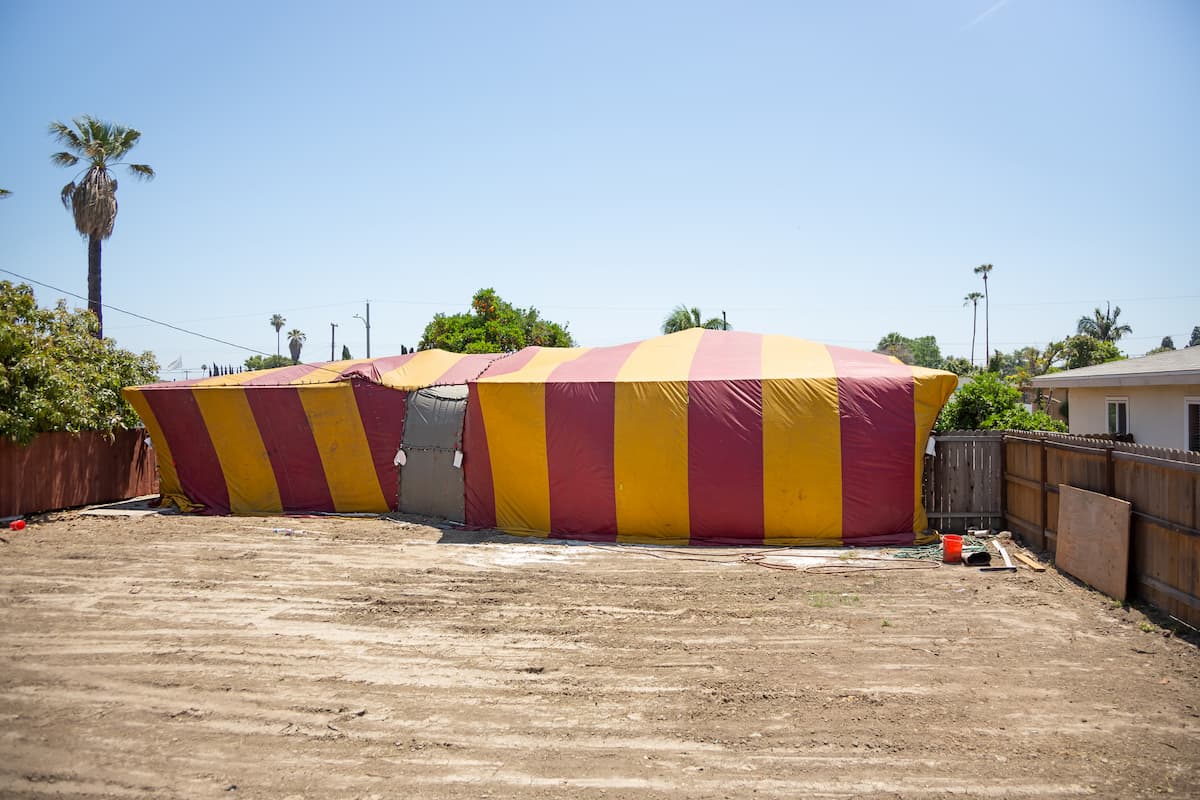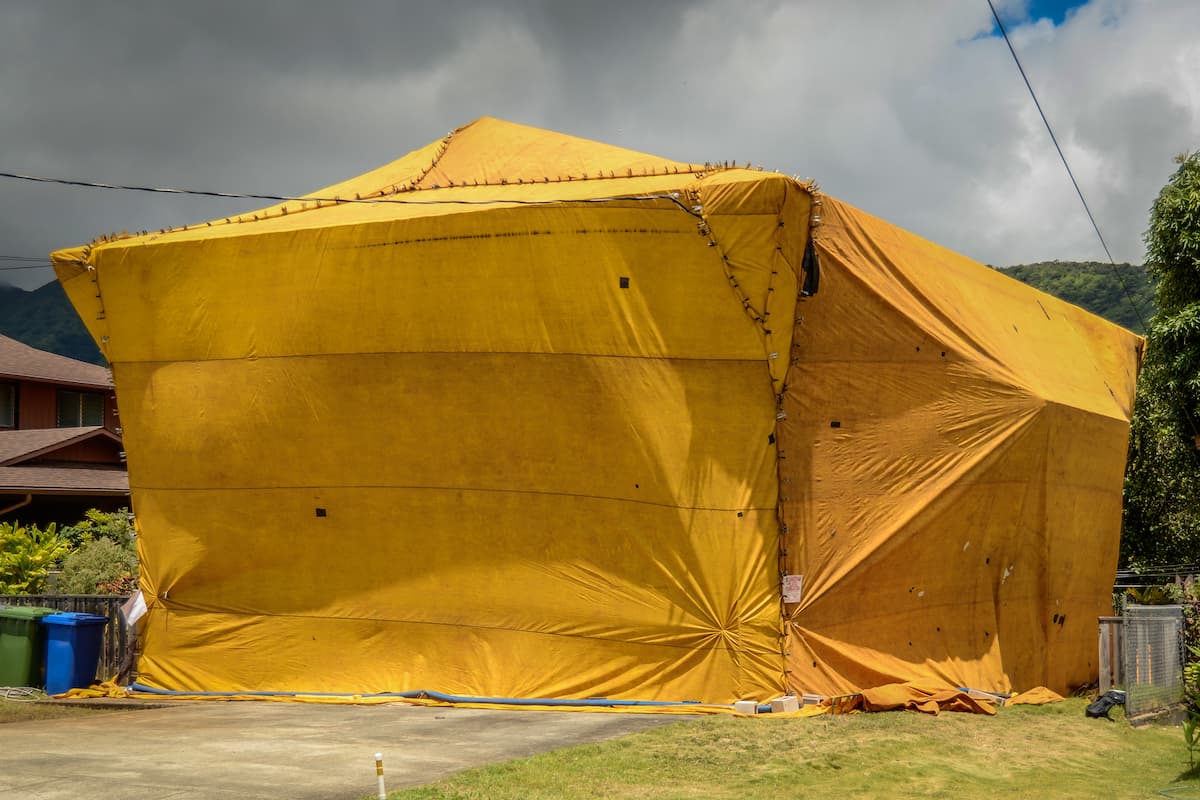What Is Tenting For Termites?
Tenting for termites is putting a tarp (tent) over a house and spraying chemicals inside to control an infestation.
Termite tenting is the same as fumigation. It’s the last resort for pest control companies, and although effective, it’s more toxic and expensive than other solutions. Termite tenting also requires homeowners to relocate for a few days to avoid the poisonous chemicals.
If your house needs to be tented, you’re hosting a massive termite colony, and you’ll need to find the root cause to avoid a new infestation.
What Does Termite Tenting Entail?

Termite tenting is about fumigating in places that other solutions can’t reach. Termite fumigations involve placing a tarp over your house and spraying the structure with a fumigant.
It’s more common with houses with drywood termites than those with subterranean termites, as the former are more “hardcore.”
Drywood termites can survive with little moisture and tend to stay out of sight, making it hard to notice an infestation in its early stages.
Unless you conduct routine checks, you’ll likely only find out you’re hosting a drywood colony when it’s already too large for DIY extermination.
Once you’ve discovered the infestation, a pest control company will try different methods like baiting and using barriers. They suggest tenting if the infestation shows no signs of slowing down after exhausting these other strategies.
The chemical commonly used in termite tenting is sulfuryl fluoride, and it reaches the cracks inside the wood where the insects have built their nests. It strips the termites of oxygen, damaging their nervous system and killing them.
After the fumigation, the exterminator removes the tarp from the house and lets the fumigant aerate for at least six hours. The entire process up to this point takes one to three days, depending on the house size, fumigant dosage, and weather.
After the aeration, the exterminator will walk through each room with a fumigant clearing device to ensure the house is safe for re-entry.
Preparing for Termite Tenting
The pest control operator provides instructions on what to do (and what not to do) pre-fumigation. Though every company is different, the instructions revolve around the same principles.
Evacuate
Evacuation is the most crucial part of fumigation, at least on your side.
The company will let you know how long the extermination takes so you can plan, but likely you’ll have to set aside a minimum of three days.
Once the process is complete, you can call and ask for an update.
Seal All Food Items
Keep all consumables (including pet food and medicines) in airtight glass or metal containers to prevent contamination from the chemicals.
Termite fumigant doesn’t leave a residue, and you can safely consume the items afterward.
If you’re concerned, remove your food items from the house.
Double-Pack All Clothes
Leave nothing in your wardrobes and closets. Double-pack all clothes, bedding, and curtains in bags and seal all permeable items.
Uncover all Furniture
Plastic-covered furniture prevents effective penetration of the fumigant. Take off all covers (including mattress and seat covers) to ensure that the chemicals reach all the nooks and crannies.
Unplug Heating and Electrical Appliances
Most fumigants are flammable, so confirm that all appliances (including the refrigerator, television, microwave, and washing machine) are off and unplugged before leaving. You will also have to turn off the gas, if applicable.
Remove All Indoor Plants
You can trim your plants if they’re too close to the tarp, but the best solution is to remove them altogether.
Keep them away from the fumigation area so as not to hamper the exterminators. If you still choose to leave them in the house, trim them to be at least twelve inches away from the walls.
Open All Doors, Crawl Spaces, Attics
The exterminators won’t have problems opening doors to the rooms, but there might be spaces they’re not familiar with.
Before vacating, you can help by opening all the doors, crawl spaces, and other built-in storage areas, as well as drawers, closets, and cabinets.
Prep The House’s Exterior
If you’ve never done any gardening, fumigation will push you to it.
Weeds, mulch, and shrubs around the house can obstruct the exterminators as they put on the tarp, and you should trim them pre-fumigation. Also, water the vegetation around the house foundation and take out all aerials.
Does Termite Tenting Really Work?

Yes. Fumigation is the most effective pest control method; however, it also has downsides.
The first and most important is that it doesn’t prevent future infestations. Your house will be termite-free by the time you get back, but there are no assurances that you won’t have further issues.
Drywood termites are the hardest to prevent – they can enter your house from anywhere, not only from the soil. A professional will propose direct wood treatments in addition to fumigation to protect against future colonies.
You also prevent overblown infestations by scheduling annual inspections. The exterminators will detect infestations at the early stages and get rid of them quickly.
The second disadvantage of fumigation is the inconvenience – unless you’re going on an extended vacation, enjoying that much preparation and packing is hard.
You must also evacuate your house for about a week, which means restructuring your daily schedule to accommodate the temporary relocation.
The last con is that fumigations aren’t cheap, especially if you live in a large house. A 1,000-square-foot (93 sqm) home can cost between $1000-$4000, while a 3,500-square-foot (325 sqm) property can cost upwards of $5000.
When you combine the price with the other disruptive aspects of fumigation, it’s easy to see why tenting is usually the last resort.
How Safe Is Termite Tenting?
Termite tenting requires steps that aren’t present with other control methods.
The chemicals used are toxic enough for you to evacuate the place, and the process is complex enough that only licensed professionals should carry it out.
That said, exterminators use various devices to ensure the process is safe for them and your family.
Examples include the fumiscope that keeps tabs on the gas concentrations and a clearance device that detects whether the house is clear of chemicals before re-entry.
Termite tenting is the safest method regarding the potential spread of termites in your neighborhood.
Coming home and seeing your neighbor’s home tented shouldn’t worry you, as the tarp ensures the infestation is surrounded and has no place to escape. Fumigation also kills the entire population inside the tent, so removing it won’t lead to the spread of termites.
The only concern in such a situation is that if one house has a full-blown infestation, the rest of the neighborhood likely has minor cases, and you should consider scheduling an inspection for your own home.
Also, reduce the use of over-the-counter termite repellents. There’s a good chance the pests will run for cover in other houses, and who’s to say they won’t come back to yours.
Alternatives to Termite Fumigation

There are two reliable alternatives to fumigation: heating and liquid treatments.
Heating
Heating is similar to fumigation in that the exterminators will tent your house. This time, however, they will raise the temperatures inside your home, not spray it with chemicals.
Termites are sensitive to drastic changes in temperature, and heat treatments seek to expose this weakness.
Exterminators expose your house to temperatures between 130-150°F and maintain wood temperatures of 120°F for 35-60 minutes.
High temperatures kill the existing colonies, but you risk damaging your electric appliances, furniture, and anything sensitive to heat. To prepare for this process, you’ll have to remove anything that can’t take the heat (no pun intended).
Liquid Treatments
Liquid treatments involve termiticide injections in holes made in the infested areas. The process doesn’t require tenting and is more practical for protecting against future infestations than fumigation.
Conclusion
The next time you see a house looking like a circus, don’t imagine a juggling elephant walking by – the owners are just fumigating the place.
If you’re unlucky enough to need the tent yourself, you’ll also want to talk to a professional about how to prevent future infestations and implement their suggestions accordingly.
While tenting is highly effective at dealing with an immediate problem, there are alternatives to fumigation you can explore if you don’t want chemicals sprayed into your house.
No strategy is perfect, so consult with an exterminator to choose the best option for you.
